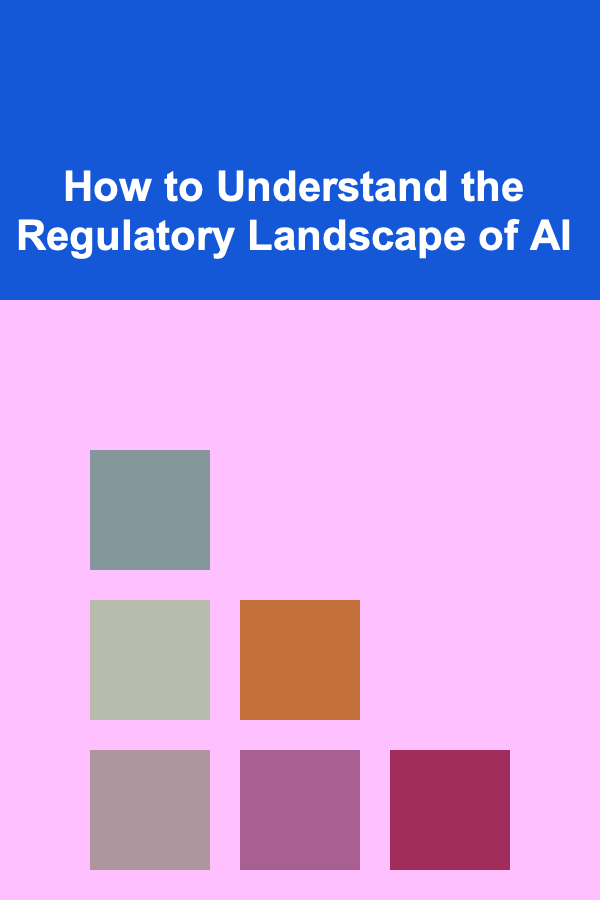
How to Understand the Regulatory Landscape of AI
ebook include PDF & Audio bundle (Micro Guide)
$12.99$11.99
Limited Time Offer! Order within the next:

The rapid growth and integration of Artificial Intelligence (AI) across various sectors have led to a significant shift in technological, social, and economic landscapes. However, with this rapid progression comes the need for regulatory frameworks to ensure that AI systems are developed, deployed, and used responsibly. The regulatory landscape surrounding AI is multifaceted and evolving, with governments, international organizations, and industry leaders actively working to establish guidelines and standards. Understanding this regulatory environment is crucial for businesses, policymakers, and developers to ensure that AI technologies are developed ethically, transparently, and with accountability.
In this article, we will explore the key aspects of the regulatory landscape of AI, including the challenges it presents, the stakeholders involved, the current regulatory frameworks, and the future directions for AI regulation.
The Need for AI Regulation
The Rising Influence of AI
Artificial Intelligence is no longer a futuristic concept; it is a reality that has already permeated industries such as healthcare, finance, transportation, manufacturing, and more. AI systems are being used for everything from automating tasks to making critical decisions in real-time. However, as AI becomes more powerful and ubiquitous, it raises important concerns related to safety, fairness, privacy, and ethics.
The growing influence of AI technologies brings with it an array of potential risks. These risks include algorithmic bias, lack of transparency in decision-making, security vulnerabilities, and the potential for large-scale job displacement. Additionally, there are concerns about AI's use in surveillance, warfare, and the manipulation of public opinion through social media platforms. Thus, there is an urgent need for regulation to address these risks and ensure AI is used for the benefit of society while minimizing harm.
Ethical and Legal Concerns
Ethical considerations are at the forefront of AI regulation. AI systems can inadvertently perpetuate or even exacerbate societal inequalities. For example, biased algorithms used in hiring processes or law enforcement could discriminate against certain groups of people based on race, gender, or socioeconomic status. Furthermore, the lack of transparency in how AI systems make decisions, commonly referred to as the "black box" problem, makes it difficult for individuals and organizations to understand how decisions are being made.
Legal concerns also play a critical role in the regulatory landscape. In many jurisdictions, existing laws do not adequately address the unique challenges posed by AI technologies. For example, issues related to data privacy, intellectual property, and liability in the case of AI-driven harm require a rethinking of current legal frameworks. AI regulation aims to address these concerns by creating new laws and amending existing ones to keep pace with technological advances.
The Key Stakeholders in AI Regulation
The regulatory landscape of AI involves a variety of stakeholders, each of whom has a unique role in shaping AI policy and governance. These stakeholders include governments, international organizations, private industry, civil society, and academic institutions.
Governments
Governments play a central role in AI regulation. They have the power to create and enforce laws that govern the development and deployment of AI systems. Many countries have started to draft AI-specific regulations to address concerns related to data privacy, cybersecurity, and the potential for AI to disrupt labor markets.
Governments are also responsible for ensuring that AI technologies are developed in a way that aligns with national priorities, such as public safety, economic growth, and social well-being. To this end, many governments have established AI strategies and innovation policies that guide the direction of AI research and development within their borders. These strategies often include provisions for AI regulation, funding for AI research, and partnerships with industry stakeholders.
International Organizations
AI regulation is not confined to national borders. As AI technologies are global in nature, there is a need for international cooperation to ensure consistent standards and guidelines for AI development and use. International organizations such as the European Union (EU), the United Nations (UN), the Organisation for Economic Co-operation and Development (OECD), and the World Economic Forum (WEF) are actively involved in AI governance.
The EU, for example, has been a leader in AI regulation. The European Commission has proposed the Artificial Intelligence Act, which is designed to create a comprehensive regulatory framework for AI in Europe. The Act takes a risk-based approach, categorizing AI systems into different risk levels (low, high, and unacceptable), and it sets out requirements for transparency, accountability, and human oversight.
Other international organizations focus on promoting responsible AI development globally, addressing cross-border issues such as AI's impact on employment, its potential for misuse in warfare, and its role in privacy violations.
Private Industry
Private companies, particularly those involved in the development of AI technologies, have a significant stake in AI regulation. Tech giants such as Google, Microsoft, Amazon, and IBM are at the forefront of AI research and development, and their products and services are often subject to regulatory scrutiny. These companies are keenly aware that regulation could impact their business models, influence their competitive positioning, and affect the adoption of AI technologies.
In addition to influencing regulation, private industry often plays a role in self-regulation through industry standards and guidelines. Many tech companies and AI developers have adopted internal ethical principles or established AI ethics committees to ensure that their AI systems are developed responsibly.
Civil Society and Academia
Civil society groups, including consumer rights organizations, advocacy groups, and think tanks, are increasingly involved in AI regulation. These organizations often focus on ensuring that AI systems are developed in a way that protects human rights, promotes fairness, and safeguards privacy. They advocate for policies that protect vulnerable populations from the potential negative effects of AI, such as discrimination or exploitation.
Academic institutions also play a critical role in the regulatory landscape of AI. Scholars and researchers contribute to the development of ethical AI frameworks, conduct research on AI's social and economic impact, and provide the evidence needed to support or challenge regulatory proposals. Their work often informs public policy debates and can influence the direction of AI regulation.
Current Regulatory Frameworks for AI
While AI regulation is still in its early stages, several frameworks have been proposed or enacted at the national and international levels. These frameworks vary in their approach but generally focus on ensuring that AI technologies are developed and used in a manner that is transparent, accountable, and aligned with ethical principles.
European Union's AI Act
The European Union has been a global leader in AI regulation. In April 2021, the European Commission proposed the Artificial Intelligence Act, a comprehensive regulation that aims to establish a legal framework for AI in the EU. The Act takes a risk-based approach to regulation, categorizing AI systems into four risk levels:
- Unacceptable risk: AI systems that pose a threat to public safety, such as social scoring systems and autonomous weapons, are prohibited.
- High risk: AI systems used in critical sectors such as healthcare, law enforcement, and transportation must comply with strict requirements related to transparency, documentation, and human oversight.
- Limited risk: AI systems that have moderate risk (e.g., chatbots or recommendation systems) must meet minimal requirements for transparency and accountability.
- Minimal risk: AI systems that pose little to no risk, such as spam filters or AI-driven video games, are subject to light regulation.
The European Union's AI Act represents one of the most comprehensive and ambitious regulatory attempts to govern AI. It seeks to strike a balance between fostering innovation and protecting fundamental rights.
United States' Approach to AI Regulation
In the United States, AI regulation is more fragmented, with various agencies and bodies addressing AI-related issues in specific sectors. The U.S. government has yet to pass a comprehensive national AI regulation law, but several initiatives have emerged. For instance, the National Institute of Standards and Technology (NIST) has developed voluntary guidelines for AI governance, including fairness, transparency, and explainability. These guidelines aim to support AI developers in building systems that are both effective and ethical.
In addition to federal efforts, some states have introduced their own AI regulations. For example, California passed the California Consumer Privacy Act (CCPA), which includes provisions related to AI and data privacy.
China's AI Regulation Landscape
China's approach to AI regulation has been characterized by both rapid innovation and increasing government control. The Chinese government has been proactive in developing AI policies and standards, with a focus on promoting AI development while maintaining social stability and security.
In 2017, China introduced its Next Generation Artificial Intelligence Development Plan, which aims to position the country as a global leader in AI by 2030. While the plan is focused on fostering innovation, it also outlines the need for AI governance, particularly in areas such as ethics, security, and privacy.
China's regulatory approach has also been shaped by concerns about AI's potential impact on privacy and social order. The government has implemented regulations that govern the use of AI in facial recognition technology, and there are ongoing discussions about how to balance innovation with privacy protection.
The Future of AI Regulation
The regulatory landscape of AI is still evolving, and its future will likely be shaped by several key factors, including technological advancements, public opinion, and global cooperation.
Global Harmonization
As AI technologies transcend national borders, there is an increasing need for global harmonization of AI regulations. International cooperation will be essential to create unified standards for AI development and use. This will require countries to engage in diplomatic negotiations and adopt common principles that ensure AI is used responsibly while fostering innovation. Organizations like the OECD and the UN are likely to play a central role in facilitating this process.
AI Governance Frameworks
The future of AI regulation will likely see the development of more comprehensive governance frameworks. These frameworks will be designed to ensure that AI technologies are developed and used ethically, with a strong emphasis on transparency, accountability, and human oversight. They may include provisions for regular audits of AI systems, mechanisms for redress in cases of harm, and guidelines for the responsible use of AI in high-risk areas such as healthcare and criminal justice.
Ethical AI Development
As AI systems become more powerful and complex, the need for ethical guidelines will become more pressing. Future AI regulation will likely include robust provisions for ensuring that AI systems are designed with fairness, transparency, and accountability in mind. The development of AI ethics principles will be critical in ensuring that AI systems do not perpetuate bias or discrimination, and that they respect the privacy and dignity of individuals.
Conclusion
The regulatory landscape of AI is complex and rapidly evolving. As AI technologies continue to shape the future, it is crucial that governments, international organizations, industry leaders, and civil society work together to develop regulatory frameworks that ensure AI is developed and used responsibly. By striking a balance between fostering innovation and protecting the public interest, we can ensure that AI serves as a force for good in society.

How to Make Money Online as a Compliance Officer: 10 Actionable Ideas
Read More
How to Organize Your Essential Oils for Craft Projects
Read More
How to Utilize Over-the-Toilet Storage Solutions
Read More
How To Use Ear Candling for Wellness
Read More
How to Explore the Myths of the Arctic Regions
Read More
How to Dress Appropriately in Different Cultures
Read MoreOther Products

How to Make Money Online as a Compliance Officer: 10 Actionable Ideas
Read More
How to Organize Your Essential Oils for Craft Projects
Read More
How to Utilize Over-the-Toilet Storage Solutions
Read More
How To Use Ear Candling for Wellness
Read More
How to Explore the Myths of the Arctic Regions
Read More